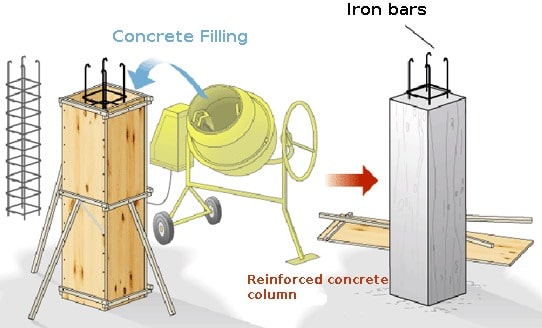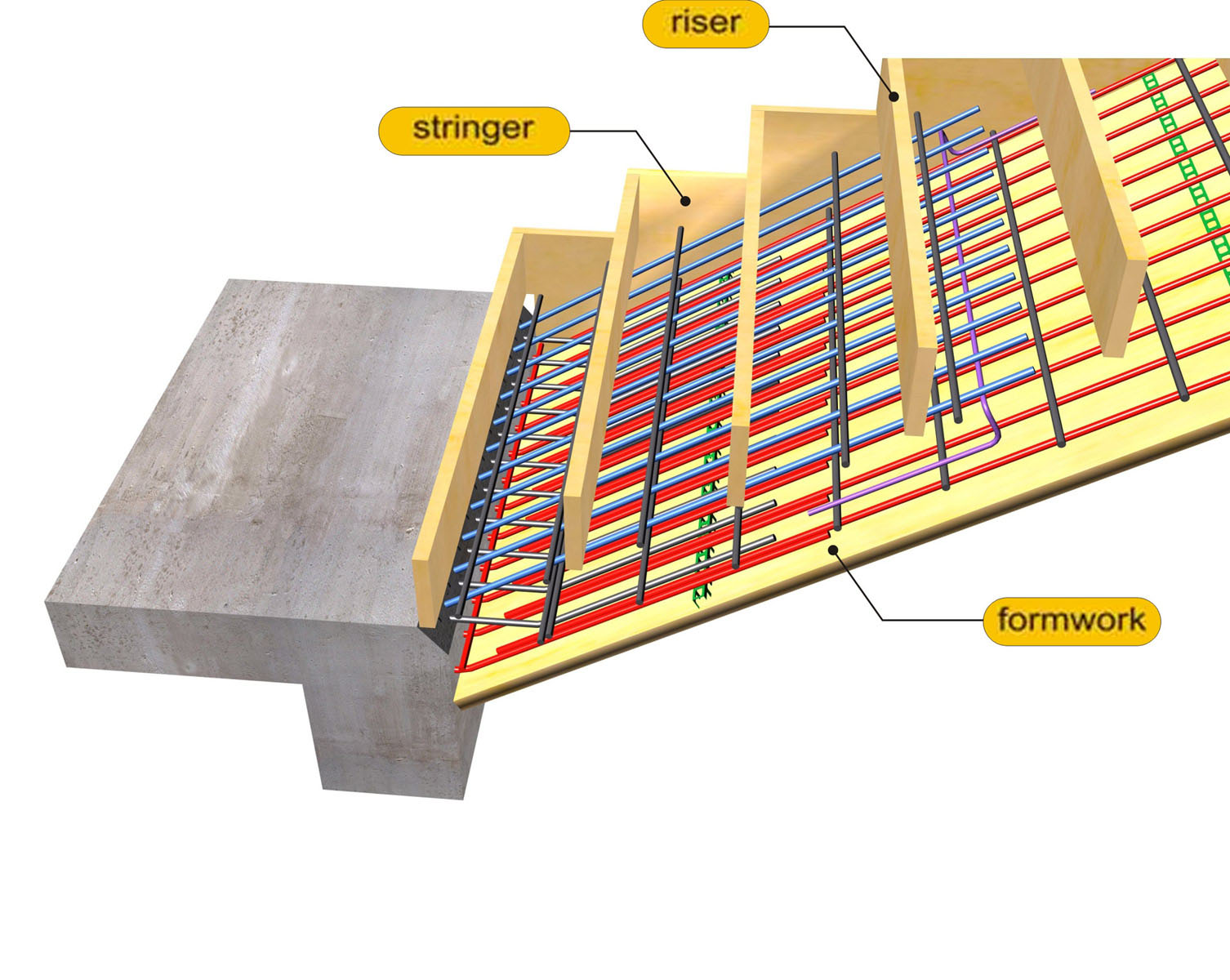what is Formwork
Formwork is a moulds including all supporting structures, used to shape and support the concrete until it attains sufficient strength to carry its own weight. It should be capable of carrying all imposed dead and live loads apart from its own weight.

Requirements good formwork
1. It should be strong enough to withstand all types of dead and live loads.
2. It should be rigidly constructed and efficiently propped and braced both
horizontally and vertically, so as to retain its shape.
3. The joints in the formwork should be tight against leakage of cement grout.
4. Construction of formwork should permit removal of various parts in desired
sequences without damage to the concrete.
5. The material of the formwork should be cheap, easily available and should
be suitable for reuse.
6. The formwork should be set accurately to the desired line and levels should have plane surface.
7. It should be as light as possible.
8. The material of the formwork should not warp or get distorted when exposed to the elements.
9. It should rest on firm base.
Economy in formwork
• The cost of formwork may range between 30 to 40% of the cost of concrete work.
• Special structure like bridge ,tall chimneys, dams etc; the cost of formwork may range between 50 to 100%.
• The building should be planned in such a way that there are minimum number of various in the size rooms, floor area etc. so as to permit reuse of the formwork moulds repeatedly.
• Formwork shall be made of low cost materials, energy and labor if possible.
• Formwork care and maintenance should be done according to specifications.
Types of formwork
- Timber formwork
- Steel formwork
- Plywood formwork
- Aluminum formwork
- Plastics formwork
Timber formwork
- It should be well seasoned.
- It should be light weight.
- It should be easily workable
- with nail without splitting.
- It should be free from knots
- Advantage of timber formwork:
- Easy handling because it is light weight.
- Easy to disassemble.
- Damaged parts can be replaced with new one.
- Very flexible.
- Easy to produce.
- Easily available.
Disadvantage of timber formwork
- Limited size of shape.
- Excessive loss of heat.
- A very smooth surface will be problems for finishing process.
Steel formwork
• This consists of panels fabricated out of the thin steel plates stiffened along the edges by small steel angles.
• This consists of panels fabricated out of the thin steel plates stiffened along the edges by small steel angles.
• The panel units can be held together through the use of suitable clamps or bolts and nuts.
• The panels can be fabricated in large number in any desired modular shape or size.
• Steel forms are largely used in large projects or in situation where large number reuses of the shuttering is possible.
• This type of shuttering is considered most suitable for circular or curved structures.
Advantages of steel formwork
• It can be used for a no. of times.
• It is non absorbent.
• Smooth finish surface obtained.
• No shrinkage of formwork occurs.
• Easy to use.
• Its volume is less.
• Its strength is more.
Disadvantage of steel formwork
• Limited size or shape.
• Excessive loss of heat.
• A very smooth surface will be produced which would give problems for finishing process.
• Limited fixing.
Aluminum formwork
• Manufactured using light weight aluminum.
• Made up of aluminum metal frame that provides very sturdy and durable mold for pouring concrete.
Advantages of aluminum formwork
• Quickly and accurately assembled.
• Reduces the labor cost owing to its easy installation.
• Light weight component provides low pressure on the lower part of the buildings.
• Aluminum metal surface offers easy cleaning after concrete is removed.
• Faster construction cycles.
• Easy to handle.
• High quality finishes.
• Can be easily recycled.
• Can be repeatedly used without losing quality
• Safe work platforms.
Disadvantages of aluminum formwork
• Initial high investment.
• Compares very poorly on modifications, against brick work constructions.
• Fear of theft of valuable Aluminum Extrusions & sheets & hence kit not being complete at critical stages of construction.
• Mass Housing projects are not as high for investing in large number of Aluminum Formwork.
Plywood formwork
• The plywood is built up of odd number of layers with grain of adjacent layers perpendicular to each other.
• Plywood is used extensively for formwork for concrete, especially for sheathing, decking and form linings.
• There are two types of plywood – internal and exterior.
• The interior type is bonded with water resistant glue and exterior type is bonded with water proof glue.
Advantages of plywood formwork
- Easily cut to shape on site.
- Reusable.
- Thinner plywood is used to facilitate bending.
- Thicker plywood is used when the weight of concrete caused a standard thickness plywood to blow out, it might distorting the concrete face.
Disadvantages of plywood formwork
- The layering effect in plywood makes it porous and susceptible to water damage if exposed over time.
- Plywood becomes heavy when wet and should be covered if left outside to reduce the risk of water damage.
Plastic formwork
• Lightweight
• Reusable
• Chemical resistant
• Fungus and termites resistant
• Can be easily cut and nail by using wood working tools.
• Non degradable
Construction of formwork
• Propping and centering.
• Shuttering.
• Provision of camber.
• Cleaning and surface treatment.
Order and method of removing formwork
• Shuttering forming the vertical faces of walls, beams and column sides should be removed first as they bear no load but only retain the concrete.
• Shuttering forming soffit of slabs should be removed next.
• Shuttering forming soffit of beams, girders or other heavily loaded shuttering should be removed in the end.
RCC column formwork

Stair formwork

Causes of formwork failure
• Improper stripping and shore removal.
• Inadequate bracing
• Vibration
• Unstable soil under mudsills, shoring not plumb.
• Inadequate control of concrete placement.
• Lack of attention to formwork details.
Safety precaution
• Material used for the construction of formwork must fulfill the specification.
• Formwork is fixed firmly & properly
• Construction area must be protected to prevent vandalism of formwork.